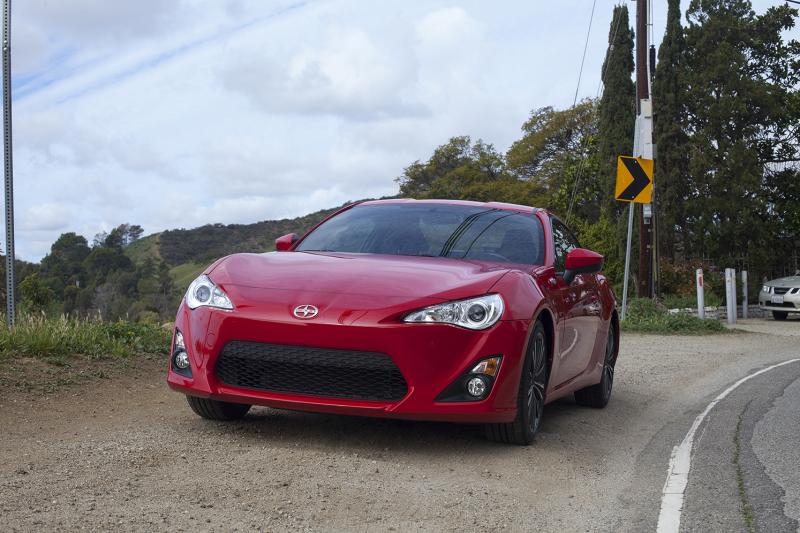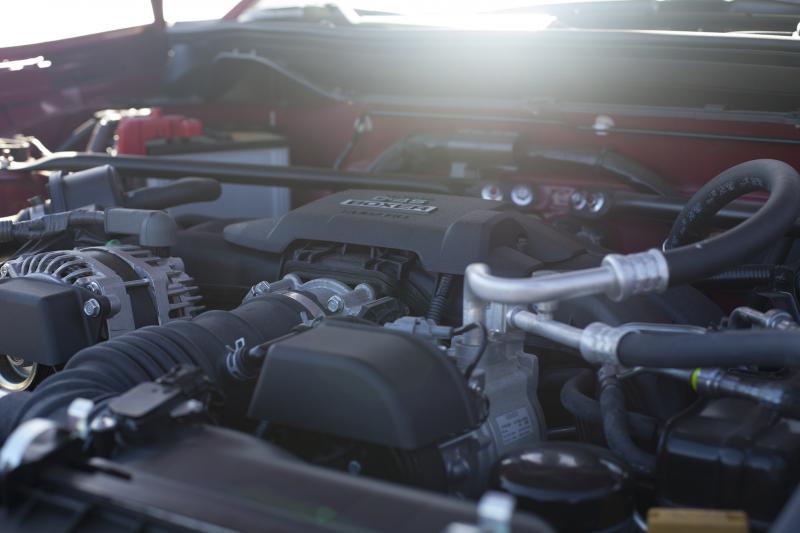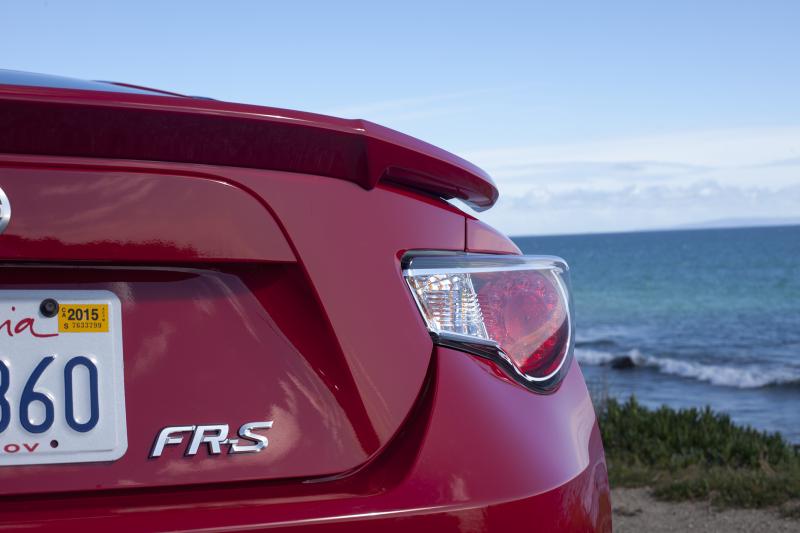Get The Three-Pedal Version: 2015 Scion FR-S Automatic, Reviewed

If I told you right now that you could buy a brand new, low-riding rear wheel drive coupe with superb handling characteristics for less than $27,000, what would you say?
You might say I'm talking nonsense and tell me to get lost. Or you'd name cars like the Chevrolet Camaro, Dodge Challenger, Hyundai Genesis Coupe or the Ford Mustang V6. Yep, those all fit the bill but in this case, I'm talking about a Scion.
SEE ALSO: 2015 Honda Civic Si Coupe Review
Meet the Scion FR-S. First, the name isn’t just a random mess of letters that have been mashed together. FR-S stands for Front-engine, Rear-wheel drive Sport. There’s a lot of importance in the fact that this car has a rear wheel drive, as getting a brand new rear wheel drive car for under $30,000 isn’t particularly easy, and when you do, you end up with a rear wheel drive coupe, similar to this one. Yet the FR-S makes itself very different from the competition by thinking well outside of the box.
First, let’s start with weight. It’s well known that a car that is heavier will not stop, start, or steer as well as one that is light. The FR-S weighs just around 2,700 lbs for the manual transmission and around 2,800 lbs for the automatic. To put this into perspective, the manual FR-S weighs a whopping 768 lbs less than the 2015 Ford Mustang V6 manual.
To achieve this, the FR-S was placed on a crash diet. The car is very small, with reduced sound deadening and extensive use of aluminum on the body panels. The steering wheel is buttonless and the highly supportive front bucket seats are manually adjustable. You don’t get automatic A/C either. There are rear seats, but they’re so small that you’ll only able to carry passengers who are incredibly short if you have someone sitting in the front. Trunk space is also limited, as it has a very shallow floor. The baseball mitt-sized rear seat does fold down to increase the trunk space, so practicality isn’t completely out the window.

The FR-S is powered by a 2.0 liter DOHC 16-valve boxer engine with Toyota’s D-4S system and VVT (codename FA20). The FA20 produces 200 horsepower at 7,000 RPM and 151 lb.-ft. at 6400 RPM. That’s a figure of 100 horsepower per liter, even more impressive when you consider the price.
The D-4S system is very loud when idle; in fact, it's so loud you can hear it from inside the car with the windows shut. The good news is that the boxer design allows the car to be mounted low down for a low center of gravity to improve handling; a standard Torsen limited-slip differential seals the deal. So, a small, lightweight rear drive chassis with a low center of gravity for both the engine in the car with a 100 hp/L engine and a limited-slip differential? In theory, this should be the answer Nissan S chassis and AE86 owners are looking for. But how does this car drive in real life?
I’ve said it once and I’ll say it again. This is one of the best handling cars I’ve ever driven. A weighted steering wheel helps you direct the car with precision and grace. The steering is responsive and communicative, and despite utilizing electric power steering, it has the weight and feel of a hydraulic system. The limited-slip differential always keeps the power going, and the boxer engine is extremely responsive. The best way to describe the FR-S is a throwback to early '80s and '90s cars - it reminds me of simpler times, when Japanese rear-drive cars were all about good, simple fun.
Before you get all excited and turn the traction control off to re-enact Ken Block’s Gymkhana 279, you should know that the Michelin Primacy tires fitted on the FR-S are only 215mm wide. This means that with the traction control turned off, the width of the tires will cause the car to slide very easily. If you’re scared about the tail sliding out, do not touch the traction control button, ever (unless you’ve accidentally turned it off and need to turn it back on). You can still have fun in the bends with the control on, as the aggressive programming will eliminate any tire slip and reward you with grip, even when you throw it around.

Helping the car slingshot around corners is the stiff suspension. For events like autocross or track days, the stock suspension is more than enough. It reacts very quickly and you won’t need to swap them out for a coilover set. The springs are so highly tuned for performance that comfort has largely gone out the window. The ride can make even smooth roads appear to have the texture of the underside of a Nestle crunch bar. On high speeds on the freeway, the ride becomes relatively tolerable; slow down to around 45 mph for traffic and it's what I’d imagine it’d be like to sit on top of a grand piano and ride it down the grand staircase of the Titanic. To sum it up, the suspension is great for sporty driving and automotive events but rubbish for everything else.
Here’s one thing that should never have been offered on the FR-S: an automatic gearbox. Now, before all you Automatic enthusiasts come showing up to the newsroom with pitchforks and torches shouting, “Automatics can shift faster than manuals,” allow me to explain. Yes, in most circumstances, modern automatics can shift gears faster than most people, especially when the “automatic” is a twin-clutch gearbox. But in the case of the FR-S’s automatic, you’re given slow shifts and taller gears.
If you don’t particularly care about sporty cars and just want to get from point A to point B, you won’t find a problem with the gearbox. The problem is that the FR-S is meant to be driven for fun. You can engage sport mode all you want to try and make the upshifts faster, but every time you pull the paddle or push the gear stick for an upshift, you'll be greeted by a delay reeking of a torque converter. The car will also blip the throttle for any downshift, but that doesn’t detract from the fact that the gearbox as a whole doesn’t feel properly matched to the engine. The tall gearing doesn’t take full advantage of the engine, and as a result, acceleration is brisk, but nothing to get excited about. Since the manual transmission equipped with the FR-S has a shorter gear kit and weighs nearly 50 lbs less, acceleration should technically be notably faster. The upside to the tall gearing is increased fuel economy and lower RPMs, as at 80 mph, the car rotates at 2,600 RPM. But in a car like this, wouldn’t you just want performance, excitement and nothing less? If the FR-S had a faster shifting, close ratio box as the automatic option, it would be a different story.
The automatic gearbox can and should be avoided for another good reason: it costs less with the manual gearbox. And here are some costs to consider: the manual FR-S starts at around $25,500. The automatic? Around $26,600. The options, like in any car, will add up depending on how many you get. In my test car for example, the rear spoiler on the car was $400, the navigation system (which got me lost four times), $1,200. The total options on my test car ended up bringing up the final price up to $29,560. Since the FR-S has a very large modding community with a wealth of parts available, you’d be better off going that route instead.
To sum everything up, the automatic FR-S is neither here nor there. It's not going to win the hearts of very many enthusiasts due to the automatic transmission’s “performance muzzle," and it won’t win over regular point A to point B commuters due to its harsh ride and impracticality. If you’re a real enthusiast, get the FR-S with the manual transmission -- you’ll thank me in the end, as you’ll be able to take full advantage of the car’s engine. If you just want to get from one place to another in a good-looking car, the Corolla S is a better choice for you.

Overall Score: B-
Hot Cars under $30,000 score: C+
Rear Wheel Drive Performance score: B-
Neon Tommy Class: Hot Cars under $30,000, Rear Wheel Drive Performance*
Price as tested: $29,561
At-A-Glance Specifications
Engine: 2.0L DOHC 16-valve D4-S boxer-four with VVT “FA20”
Horsepower: 200 hp @ 7,000 RPM
Torque: 151 lb-ft @ 6,400 RPM
Transmission: 6-speed automatic (Tested) or 6-speed manual
Tire Size: 215/45R17
Tire: Michelin Primacy HP summer tires
Curb Weight: 2,758 lbs (Automatic)
Weight Distribution F/R:
Cargo Volume: N/A
Our combined MPG: 26.9 MPG
Fuel Capacity: 13.2 gal.
MPG (EPA Estimated)(City/Highway/Combined): 25/34/28 (Automatic Transmission)
*This vehicle is the benchmark vehicle for this class.
Reach Staff Reporter Amou "Joe" Seto here.



